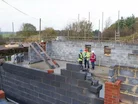UK Construction output to drop 25% according to ‘optimistic assessment’

The Construction Products Association (CPA) estimates that construction output in the UK is set to plunge by a quarter in its most optimistic assessment.
The firm revealed, in its latest forecast, that the output in the industry to go V-shaped with a drop of 25 per cent during 2020 and then a rebound of 26 per cent for 2021. This has been described by CPA as the most optimistic view and is just one of a few scenarios included in the forecast.
If a second wave of the virus sweeps across the UK following eased lockdown restrictions, a return to a more comprehensive lockdown would get in the way of the industry getting back up to speed causing a longer period of low activity. If this does occur, CPA expects that output could fall by almost a third (31 per cent) and would be 19 per cent lower than the 2019 figures by the end of 2021.
A rise in cases during the winter months through the end of 2020 and into the beginning of 2021 could require the need for increased social distancing measures to be put in place which could lead to a ‘W-shaped’ recession and outlook which could result in output falling by a third, with the total output being 16 per cent lower than the 2019 figure by the end of next year.
SEE MORE:
-
IT CIOs are placing their bets on mission-critical tech following COVID-19
-
COVID-19 losses: How technology can help the industry recover
Last month, it was calculated that 60% of planned output was lost thanks to the nationwide lockdown and strict social distancing rules. Numerous construction projects were put on hold or severely reduced in progress.
During April, the falls in output varied across sectors and nations with an estimated 83 per cent of construction work in Scotland lost due to stricter lockdown measures, where all non-essential construction work was required by the government to be stopped.
The worst affected sector was housebuilding, with 85 per cent of work being lost. Repair and improvement work fell by 60%. In addition, non-residential new-build saw a drop of 60 per cent but non-residential repair and maintenance faired better with a loss of one-fifth thanks to essential infrastructure work such as roads and railways being brought forward.
Noble Francis, Economics Director for CPA, said: “For the fortunes of construction more generally, the near-term effect of COVID-19 on the economy and employment are likely to be considerably greater than those faced during the financial crisis of 2008/09.
“In addition to these issues around the general economy and construction demand, productivity on site has fallen significantly due to social distancing and other safety, which means that construction activity will take longer and cost more. Even in our most optimistic scenario, construction output bounces back by 25.5% in 2021 but, with growth starting from a low base, output will still be 6% lower than in 2019.”
Learn more about construction topics by reading the latest editions of Construction Global. Follow us on LinkedIn and Twitter for even more cool content.
- Sustainable Materials Behind Game-Changing MycoToiletMaintenance & Operations
- Siemens & Samsung: Powering Next-Gen Infrastructure ProjectsTechnology & AI
- Eneco: How Is Grid Congestion Halting Dutch Construction?Sustainability & Green Building
- Bangkok Emerges as SE Asia’s New Data Centre PowerhouseTechnology & AI



